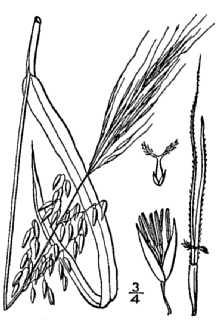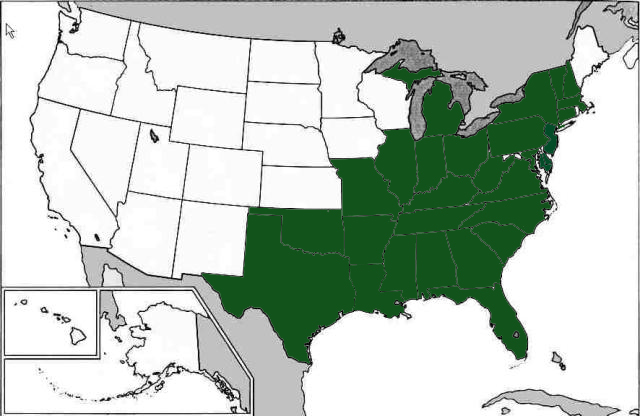Zizania aquatica
 |
|
Photo Courtesy Renee Brecht |
Britton & Brown |
| Botanical name: | Zizania aquatica |
| Common name: | wild rice |
| Group: | monocot |
| Family: | Poaceae |
| Growth type: | forb/herb |
| Duration: | perennial |
| Origin: | native |
| Plant height: | to 10' |
| Foliage: | large grass, thick, spongy; strap like leaves, 3-4' long; drooping male flowers are straw colored to purplish; female flowers hug stem and fall off easily |
| Flowering time: | Mid-July to August |
| Habitat: | quiet marshes, brackish river, fresh water rivers |
| Range in New Jersey: | throughout southern New Jersey and much of northern New Jersey |
| Heritage ranking, if any: | n/a |
| Distribution: |  |
| Misc. | Of great importance to waterfowl and migrating birds. Maurice River
watershed contains the largest stand of wild rice in the state of New
Jersey. Stone, in 1910, says " Plentiful in water along the larger rivers and swamps of the Middle and Cape May districts and the Coastal strip, running well up into the Pine Barrens along the principal water courses, but not strictly speaking, a member of the Pine Barrens flora. "This is the Wild Rice which covers the broad marshes of the Delaware as well as those of Newark and Hackensack, associated with Cat-tails, Spartina and Phragmites. By the latter part of July it is in full flower, and the drooping sprays of staminate flowers and broad green leaves remind one of a field of narrow leaved corn. In September it has become the shelter of thousands of reed birds and rail, and the gunners soon begin to beat and trample it down in pursuit of their game. The storms of autumn complete the work and by winter the acres of swaying and fluttering foliage are reduced to a dense brown mat which covers the marsh and through which, in the following spring, the tender green sprouts of the next year's cop push their way and once again give color to the meadows. "The Rice sometimes follows the course of small streams for many miles back from the rivers or coast. I have found it on Cooper's Creek, twelve miles from its mouth, while it follows the larger streams as far as the head of tidewater. Very often a dam makes a sharp line of demarkation between the tidewater and Pine Barren floras, as at Toms River, Batsto, Mays Landing, Millville, etc., and checks abruptly the range of the Wild Rice."(214-215) |